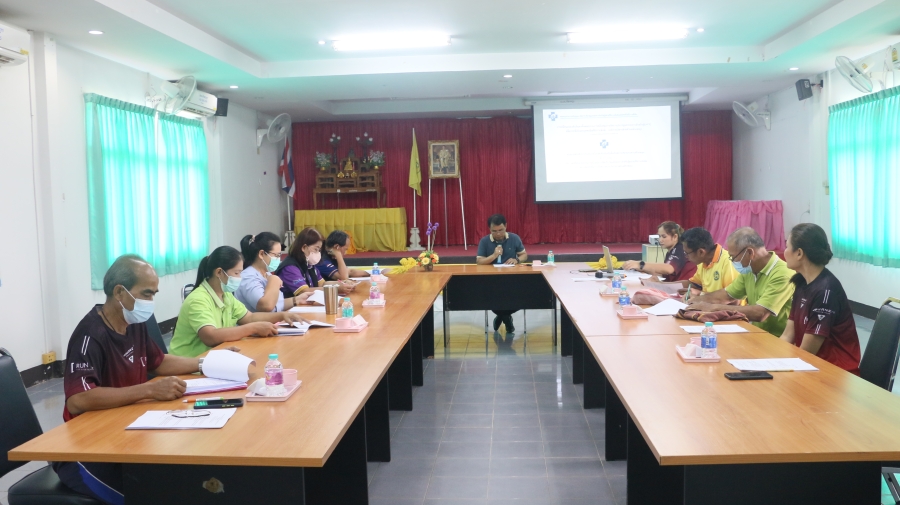ประชุมคณะอนุกรรมการสนับสนุนการจัดการบริการดูแลระยะยาวสำหรับผู้สูงอายุที่มีภาวะพึ่งพิงและบุคคลอื่นที่มีภาวะพึ่งพิง องค์การบริหารส่วนตำบลห้วยขะยุง ครั้งที่ 1/2566
วันอังคาร, 25 เมษายน 2566 14:1726 เมษายน 2565 เวลา 10.00 นายกำพล สายลาด นายกองค์การบริหารส่วนตำบลห้วยขะยุง เป็นประธานประชุมคณะอนุกรรมการสนับสนุนการจัดการบริการดูแลระยะยาวสำหรับผู้สูงอายุที่มีภาวะพึ่งพิงและบุคคลอื่นที่มีภาวะพึ่งพิง องค์การบริหารส่วนตำบลห้วยขะยุง ครั้งที่ 1/2566 ณ ห้องประชุมสภาองค์การบริหารส่วนตำบลห้วยขะยุง เพื่อให้คณะกรรมการพิจารณา การเปลี่ยนแปลงคำสั่ง แต่งตั้งคณะกรรมการสนับสนุนการจัดการบริการดูแล ระยะยาวสำหรับผู้สูงอายุที่มีภาวะพึ่งพิงและบุคคลอื่นที่มีภาวะพึ่งพิง เพื่อรายงานผลการดำเนินงานของศูนย์พัฒนาคุณภาพชีวิตและฟื้นฟูคุณภาพชีวิตสำหรับผู้ที่มีภาวะพึ่งพิง องค์การบริหารส่วนตำบลห้วยขะยุง ประจำปี 2565 และเพื่ออนุมัติเงินสนับสนุนงบประมาณสำหรับการจัดการบริการดูแลระยะยาวสำหรับผู้ที่มีภาวะพึ่งพิงและบุคคลอื่นที่มีภาวะพึ่งพิง ประจำปีงบประมาณ 2566 ให้แก่ศูนย์พัฒนาคุณภาพชีวิตและฟื้นฟูคุณภาพชีวิตสำหรับผู้ที่มีภาวะพึ่งพิง องค์การบริหารส่วนตำบลห้วยขะยุง
https://huaikhayung.go.th/news/activity-news/item/1241-ltc1-66?start=16970#sigProGalleria78ca00dc6e
17017 ความคิดเห็น
-
ลิงค์ความคิดเห็น

icebet casino deutschland [url=http://icebet-online.com/]icebet casino deutschland[/url] .
วันอาทิตย์, 16 พฤศจิกายน 2568 12:40 โดย : icebet casino_zemr -
ลิงค์ความคิดเห็น

What's up colleagues, its enormous piece of writing regarding teachingand fully
วันอาทิตย์, 16 พฤศจิกายน 2568 12:40 โดย : Vàng Sinh Diễn
explained, keep it up all the time. -
ลิงค์ความคิดเห็น

1xbet yeni giri? adresi [url=https://1xbet-14.com]1xbet yeni giri? adresi[/url] .
วันอาทิตย์, 16 พฤศจิกายน 2568 12:36 โดย : 1xbet_iymn -
ลิงค์ความคิดเห็น

1xbet giri? linki [url=http://1xbet-14.com/]1xbet giri? linki[/url] .
วันอาทิตย์, 16 พฤศจิกายน 2568 12:36 โดย : 1xbet_pumn -
ลิงค์ความคิดเห็น

1xbet [url=https://1xbet-14.com]1xbet[/url] .
วันอาทิตย์, 16 พฤศจิกายน 2568 12:36 โดย : 1xbet_uomn -
ลิงค์ความคิดเห็น

1xbet giri? linki [url=1xbet-14.com]1xbet giri? linki[/url] .
วันอาทิตย์, 16 พฤศจิกายน 2568 12:36 โดย : 1xbet_inmn -
ลิงค์ความคิดเห็น

1xbet guncel [url=https://1xbet-14.com/]1xbet guncel[/url] .
วันอาทิตย์, 16 พฤศจิกายน 2568 12:36 โดย : 1xbet_rimn -
ลิงค์ความคิดเห็น

1 xbet giri? [url=https://1xbet-14.com]https://1xbet-14.com[/url] .
วันอาทิตย์, 16 พฤศจิกายน 2568 12:36 โดย : 1xbet_tkmn -
ลิงค์ความคิดเห็น

1xbet resmi giri? [url=http://www.1xbet-14.com]1xbet resmi giri?[/url] .
วันอาทิตย์, 16 พฤศจิกายน 2568 12:35 โดย : 1xbet_pgmn -
ลิงค์ความคิดเห็น

bahis sitesi 1xbet [url=http://1xbet-14.com]bahis sitesi 1xbet[/url] .
วันอาทิตย์, 16 พฤศจิกายน 2568 12:34 โดย : 1xbet_pzmn
แสดงความคิดเห็น
***กรุณาแสดงความคิดเห็น ด้วยความสุภาพ เคารพต่อสิทธิของผู้อื่น ไม่ละเมิดต่อกฎหมาย และศีลธรรมอันดีของสังคม


